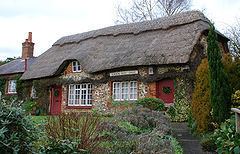Area 12.87 km (4.97 sq mi) Civil parish Slindon | OS grid reference SU961084 District Arun Local time Friday 5:33 AM | |
 | ||
Population 595 (Civil Parish.2011) Weather 8°C, Wind NE at 21 km/h, 86% Humidity Points of interest National Trust ‑ Slindon E, Gumber Bothy, Eartham Wood, Nore Hill Folly | ||
Slindon 4x4 28th august 2016
Slindon is a mostly rural village and civil parish in the Arun District of West Sussex, England, containing a developed nucleus amid woodland. Much of Slindon's woodland belongs to the National Trust on the southern edge of the escarpment of the South Downs National Park. Slindon is centred 6 miles (9.7 km) north-east of Chichester.
Contents
- Slindon 4x4 28th august 2016
- Map of Slindon UK
- Vlog travelling to slindon west sussex for easter
- History
- Amenities
- Former amenities
- References
Map of Slindon, UK
Vlog travelling to slindon west sussex for easter
History
The village is listed in the Domesday Book of 1086 as "Eslindone", the name having the probable meaning in Old English of "sloping hill".
St Mary's 12th-century parish church contains a memorial to Stephen Langton (c1150–1228), the Archbishop of Canterbury who attended the signing of Magna Carta. In the Middle Ages Slindon House (now Slindon College) was the site of one of the Archbishop's residences. In 1330 Thomas de Natindon, who was a legal representative of the Pope, was sent there to serve a writ on the archbishop. His party were not well received by the archbishop's servants who stripped and bound them, then threw cold water over them, apparently with the archbishop's consent. Natindon escaped revenge and was pursued over the hills to Petworth where he was caught and held in prison for three days.
The writer Hilaire Belloc (1870–1953) lived in the village.
In the mid-18th century, Slindon Cricket Club achieved fame through the excellence of its team which featured Richard Newland (1718–91), whose memorial is also in the church.
Amenities
In May 2012, the process began of renovating and converting the old village forge into a shop, cafe and information centre; this opened on 16 October 2012.
The village has been called the "pumpkin capital of Britain", and an annual display of pumpkins attracts tourists to the village.
A short walk from the village is Nore Folly (aka Slindon Folly), a structure built during the 18th Century by the Newburgh Family whose seat was at Slindon. The Folly resembles a gateway but leads to nowhere.
Former amenities
Slindon post office closed in 2008.. The Newburgh Arms closed in 2001. No pub remains today.
